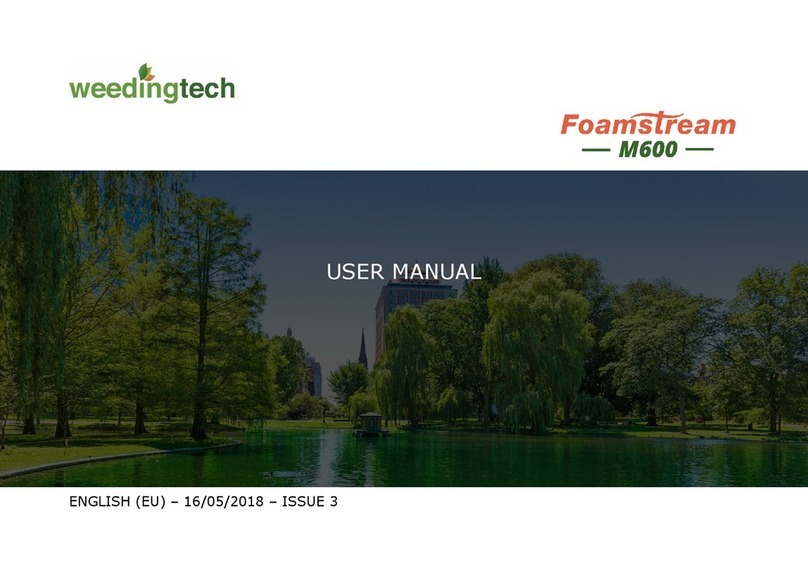L12 –User manual –English (EU/USA) –15/01/2020 - ISSUE 4
3
TABLE OF CONTENTS
1SAFETY INFORMATION _______________ 4
1.1 OPERATOR ATTENTION ________________________________________ 4
1.2 CARBON MONOXIDE HAZARDS___________________________________ 4
1.3 ELECTRIC SHOCK HAZARDS______________________________________ 4
1.4 FIRE AND BURN HAZARDS ______________________________________ 4
1.5 ENGINE FUEL WARNING _______________________________________ 4
2INTRODUCTION ____________________ 6
3IMPORTANT INFORMATION ___________ 6
4PRODUCT DESCRIPTION _____________ 7
5FOAMSTREAM® ___________________ 10
5.1 HOW FOAMSTREAM® KILLS WEEDS_____________________________ 10
5.2 INDICATORS_______________________________________________ 10
5.3 CAUTION –POISONOUS WEEDS__________________________________ 11
5.4 THE EFFECT OF THE SYSTEM ON PLANTS ____________________________ 11
6PRE-START CHECKS ________________ 13
7START PROCEDURE ________________ 14
8USING THE L12 ___________________ 15
8.1 GREEN TOWER LIGHT (AND USE OF TRIGGER) _____________________ 15
8.2 BOILER SWITCH __________________________________________ 15
8.3 THERMOSTAT ___________________________________________ 15
8.4 TACHOMETER ___________________________________________ 15
8.5 PRESSURE GAUGE ________________________________________ 15
8.6 CHANGING LANCE ________________________________________ 15
8.7 AUTOMATIC PROTECTION__________________________________ 16
9FOAMSTREAM® APPLICATION (KILLING
WEEDS)____________________________ 17
10.1 HOSE REEL ________________________________________________ 17
10.2 SPEED ___________________________________________________ 17
10.3 USE OF THE LANCE___________________________________________ 17
10.4 TREATMENT OF THICK WEEDS ___________________________________ 18
10.5 CONFIRMATION OF TREATMENT__________________________________ 18
10.6 CORRECT POSTURE __________________________________________ 18
11 SHUT-DOWN PROCEDURE ___________ 19
12 BASIC FAULT FINDING______________ 19
13 SERVICE CHECKS AND INTERVALS ____ 23
14 LOADING AND HANDLING ___________ 26
14.1 ON-VEHICLE SET UP __________________________________________ 26
15 SCHEMATICS _____________________ 27
16 WARRANTY_______________________ 30
17 PRODUCT CERTIFICATION ___________ 32




























